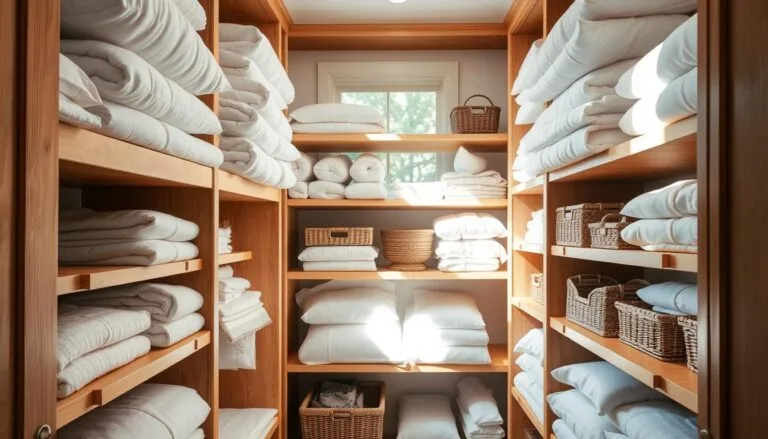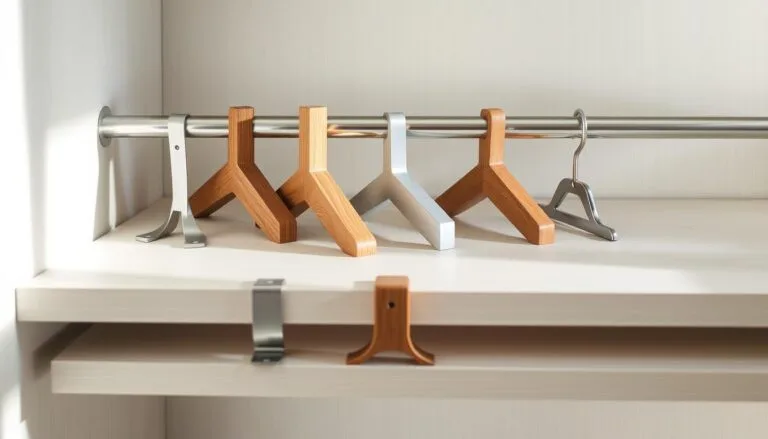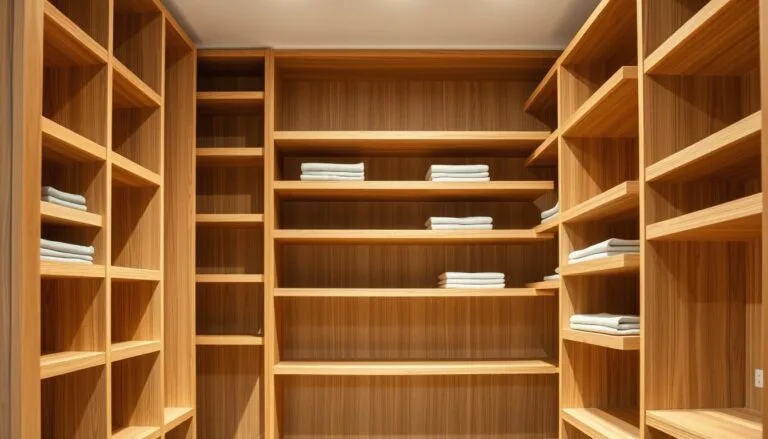Better Tips for Newborn Closet Organization and Storage
Table of Contents
Becoming a new parent is a whirlwind of joy, love, and unexpected challenges. One of those challenges? Taming the adorable chaos of your baby’s ever-growing wardrobe. Newborn closet organization isn’t just about keeping tiny clothes neat—it’s about creating a system that saves your sanity during those sleep-deprived early months.
Every parent knows the struggle of searching for a matching sock at 3 AM or frantically hunting for the right size onesie. Effective baby closet organization can transform your nursery from overwhelming to orderly. This gives you more time to cuddle and less time sorting through clothing piles.
This guide will walk you through practical strategies for newborn closet organization. We’ll cover everything from smart storage solutions to age-appropriate clothing management. Whether you’re working with a spacious walk-in closet or a compact storage area, these tips will help you create an efficient, stress-free system for your little one’s wardrobe.
Get ready to turn closet chaos into closet calm—one tiny outfit at a time.
Understanding the Essentials of Baby Closet Organization
Creating an efficient nursery closet needs careful planning and smart strategies. As a new parent, organizing baby clothes is key. The right ideas can turn a messy space into a growing storage system.
Key Items Every Newborn Closet Needs
Your newborn’s closet should have essential storage solutions. Start with adjustable hanging rods for growth. Soft fabric dividers separate clothes by size and type.
Invest in stackable clear containers for small items like socks and mittens. Ideas that focus on easy access save time in the early months.
Basic Storage Requirements for Different Age Stages
Babies grow fast, so your storage must adapt quickly. Newborn clothes need compact storage with frequent changes. As your child grows, you’ll need flexible storage solutions.
Consider using labeled bins or hanging organizers for changing sizes. This keeps everything neat and easy to find.
Common Organization Challenges for New Parents
Organizing baby clothes is unique. Tiny clothes can get lost or disorganized. Create a system for quick size and type identification.
Use color-coded hangers or drawer dividers to streamline your routine. Smart ideas can make storage efficient and manageable.
Creating a Functional Layout for Your Nursery Closet
Starting a smart closet layout is key to organizing your newborn’s room. Your tips should focus on a space that grows with your baby. Begin by dividing the closet into clear zones for quick access.
Make different areas for baby items. One for clothes, another for diapers, and a spot for blankets. Use vertical space with adjustable shelving that grows with your baby.
Place often-used items at eye level for easy reach. Use hanging organizers with many compartments for small items. Clear storage containers help you find what you need fast.
Plan for flexibility in your closet layout. Choose modular storage that can change as your baby grows. Adjustable rods fit different sizes of clothes. A well-organized closet saves time and reduces stress in those busy early months.
Smart Solutions for Newborn Closet Organization
Keeping your baby’s closet tidy can be tough. New parents find that good closet storage is key. It helps manage a baby’s changing needs. Smart ways to organize can turn a messy closet into a helpful space.
Space-Saving Hangers and Organizers
Get specialized tools for your baby’s closet. Slim velvet hangers keep clothes from slipping and save space. Cascading hangers let you hang many clothes at once, freeing up room.
Color-coded or labeled hangers make sorting clothes easy. This way, you can find what you need fast.
Drawer Dividers and Storage Boxes
Small items like socks and mittens can get messy. Drawer dividers are great for keeping things organized. Clear plastic boxes with labels help you find clothes quickly.
Stackable containers use vertical space well. They help keep your closet tidy.
Vertical Storage Solutions
Use your closet’s height to save space. Over-the-door organizers are great for accessories and diapers. Hanging shoe organizers can hold onesies and burp cloths.
These ideas keep your baby’s closet neat and organized. They make your life easier.
Organizing Baby Clothes by Size and Season
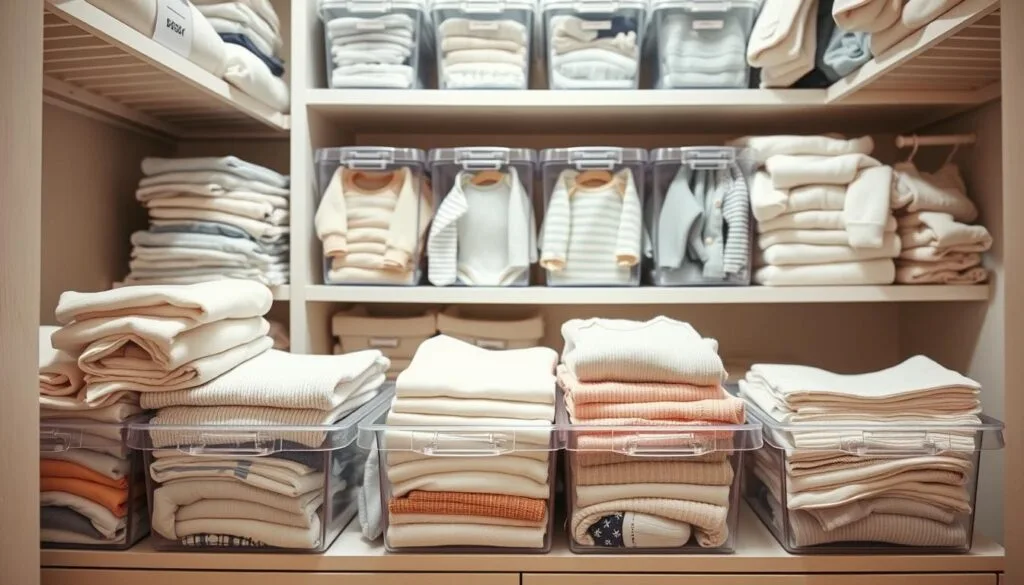
Managing your newborn’s wardrobe can feel overwhelming. Sort your clothes by size and season to keep everything neatly organized. This makes finding the right outfit easy and keeps your nursery tidy.
Sort newborn clothes into different sizes. Newborns grow fast, so have sections for 0-3 months, 3-6 months, and 6-9 months. Utilize bins or dividers to maintain an orderly space. Color-coding or labels help too.
Seasonal organization is key. Store clothes for other seasons in bags or containers. This protects fabrics and saves space. Rotate clothes as your baby grows, keeping only current sizes easy to find.
Pro tip: Keep a few extra outfits in the next size. Babies grow fast, and having these saves you from last-minute shopping. Use adjustable organizers that grow with your baby.
Regularly check your baby’s clothes. Get rid of what doesn’t fit and make room for new sizes. This keeps your baby’s closet organized and stress-free.
Maximizing Small Closet Spaces for Baby Items
Dealing with small nursery closet space can be tough for new parents. The trick is to be creative with storage. Smart ideas can turn tiny spaces into great places to store baby stuff.
When space is tight, closet storage is key. Parents should use every inch of space. This way, they can make the most of their storage.
Wall-Mounted Storage Options
Vertical storage is a big help in small closets. Adding floating shelves or hanging organizers saves floor space. Use wire baskets, pegboards, and hooks for diapers, small items, and things you use a lot.
Door-Hanging Organizers
Your closet door has lots of storage potential. Over-the-door organizers with pockets can hold socks, hair stuff, toys, and more. They keep things visible and within reach without cluttering the closet.
Under-Shelf Storage Solutions
Don’t forget the space under shelves. Sliding drawers or baskets fit well there. Store seasonal clothes, extra blankets, or things you don’t use often. This makes the most of your closet space and keeps it tidy.
Essential Storage Solutions for Baby Accessories
Organizing baby clothes is more than just hanging tiny outfits. Small items like socks, mittens, hats, and bibs can quickly clutter your nursery. Smart storage solutions can turn your nursery closet into a tidy space.
Begin with clear, stackable containers for different items. Use drawer dividers to make specific spaces for each thing. Soft fabric bins with labels help keep small items organized and easy to find. Color-coding or using clear containers makes it easy to spot what’s inside without opening everything.
Magnetic strips or hanging organizers can be a big help for small items. Put them inside closet doors or on walls to use vertical space well. Hanging mesh pockets are perfect for sorting socks, hair bows, and light items. These keep everything visible and within reach, which is crucial during busy parenting times.
Invest in multi-compartment storage systems made for baby accessories. Look for ones with adjustable sections that can grow with your child. Choose breathable materials to keep delicate items fresh and prevent moisture buildup.
Remember, effective newborn room organization is about finding a system that fits your family’s life. It’s not about being perfect. Regularly check and tweak your storage as your baby grows and your needs change.
Implementing a Rotation System for Growing Babies
As your baby grows fast in the first year, it’s important to keep their closet organized. Babies quickly outgrow their clothes, so a good wardrobe system is essential for parents.
A smart rotation system is key for managing your baby’s growing wardrobe. Use clear storage containers labeled with sizes. This makes it easy to swap out old clothes for new ones.
Managing Hand-Me-Downs
Hand-me-downs can save money on clothes. Sort them by size and season in storage bins. Check second-hand items for damage before adding them to your baby’s closet.
Storage for Future Sizes
Store clothes in sizes a bit larger than your baby’s current size. Use vacuum-sealed bags or clear containers to keep clothes fresh. Label each container with size and season for easy access later.
Check your baby’s clothes often. Get rid of items that don’t fit anymore. This keeps your closet organized and stress-free.
Labeling and Categorizing Baby Closet Items
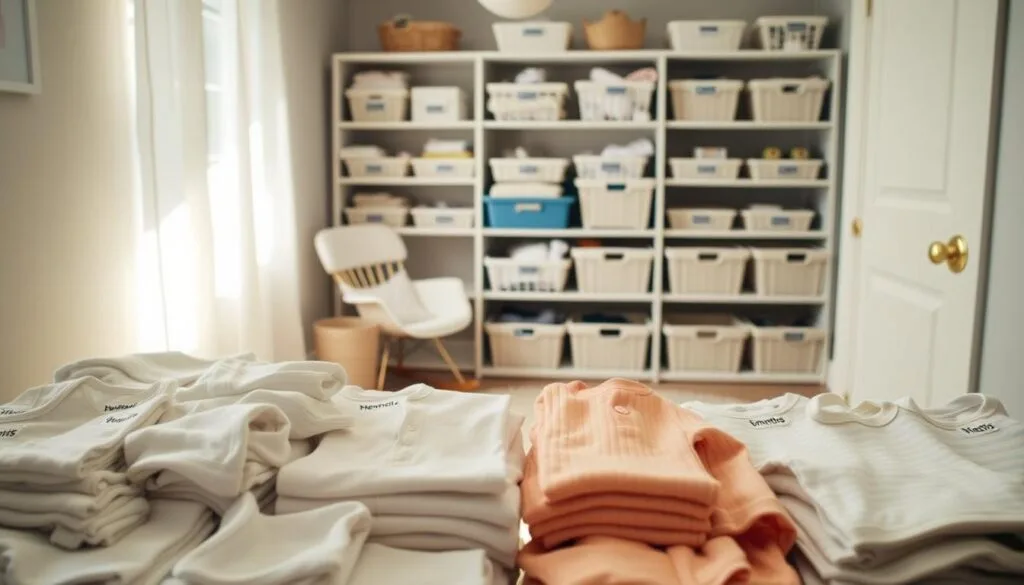
Organizing baby clothes can be tough for new parents. A smart labeling system can turn your nursery closet into a tidy space. Start with clear, removable labels to keep track of everything easily.
Color-coded labels are great for organizing. Use different colors for clothes by size, season, or type. For example, blue for 0-3 month clothes and green for summer outfits. This makes finding clothes quick and easy.
Digital label makers are a big help for parents who want to organize well. Print labels for storage boxes, hangers, and dividers. Add details like size, date, and type. This way, you can handle hand-me-downs and track your baby’s growth easily.
Think about using clear storage containers with labels. They let you see what’s inside while keeping things organized. Update labels as your baby grows to keep your space tidy.
A good labeling system makes your daily routine simpler. Spend time setting up a system that grows with your baby. This way, managing clothes will be easy.
Maintaining an Organized Baby Wardrobe Long-Term
Keeping your baby’s closet organized is a continuous effort. It needs consistent work and smart plans. Good baby closet organization helps parents keep up with their child’s fast-changing wardrobe and growth.
Creating a structured plan for organizing a newborn’s room can make it easier. Regular upkeep stops clutter from taking over. It also means you always know what clothes are available.
Weekly Organization Routine
Take 15-20 minutes each week to tidy up your baby’s closet. Go through clean laundry, toss outgrown clothes, and organize by size and type. This quick weekly check helps you keep track of your baby’s clothes and avoid buying too much.
Monthly Storage Assessment
Do a deep dive into your baby’s wardrobe every month. Look for clothes that don’t fit anymore, update storage, and switch out seasonal items. This keeps your baby’s closet organized and ready for their changing needs.
By following these steps, you’ll have a system that grows with your baby. It makes managing clothes easy and stress-free.
Budget-Friendly Organization Ideas for Nursery Closets
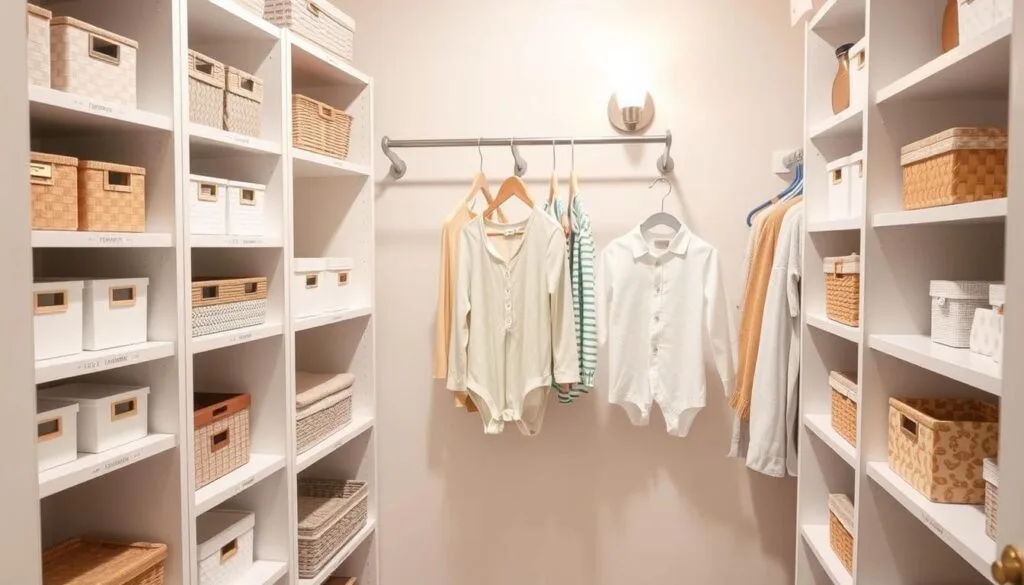
Creating an organized nursery closet doesn’t have to cost a lot. With some creative ideas, you can make smart storage solutions that save money and use space well. Start by looking around your home for items you might already have.
Use everyday items like shoe boxes, plastic containers, or mason jars for storage. Clear plastic bins are great for sorting baby clothes by size and season. You can also turn cardboard boxes into drawer dividers by covering them with decorative contact paper.
Thrift stores and discount retailers have affordable organizational tools for nursery closets. Look for hanging shelf organizers, fabric storage cubes, and adjustable shelving units. Dollar stores often have practical storage solutions at a low cost.
If you like DIY, you can make custom storage systems. Use pegboards, tension rods, or wooden dowels to create vertical storage. With a few basic craft supplies, you can make personalized storage that meets your needs.
Keep it simple for the best results. Use existing hangers and add more tension rods for hanging clothes. Try rolling baby clothes instead of folding to save space. With a little creativity and planning, your nursery closet can be both functional and budget-friendly.
Time-Saving Tips for Daily Baby Closet Management
Start by making your nursery more organized. Use quick-access storage for baby clothes. This makes getting outfits in the morning much faster.
Color-coded hangers and clear drawer dividers help a lot. They let you find clothes quickly, saving you time.
Plan your morning routine to save time. Lay out outfits the night before. Use hanging organizers with daily spots to make mornings easier.
This way, you won’t get stressed in the mornings. It’s great when you’re not getting much sleep.
Keep your laundry routine simple. Use mesh bags for small items like socks. This stops them from getting lost.
Have separate baskets for clean and dirty clothes. It makes laundry easier to manage. Your goal is to reduce clutter and make caring for your baby less stressful.
Use digital tools to help with organizing. Take photos of outfits or use apps to track clothes. This way, you use your baby’s clothes better and avoid buying too much.
A well-organized closet is more than just storage. It’s about creating a system that works with your parenting life.



